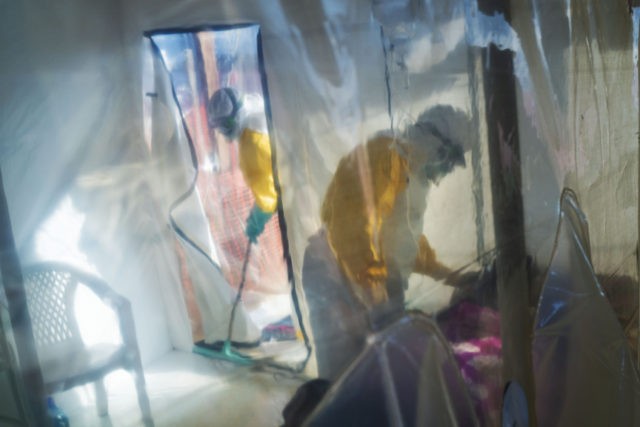The number of refugees fleeing into Uganda from the Democratic Republic of Congo (DRC, or DR Congo) in the past month has doubled, increasing the flow of those leaving the Ebola-stricken Ituri and North Kivu provinces to hundreds a day, Voice of America reported on Monday.
North Kivu is the center of the ongoing Ebola outbreak in DRC that began last year, spreading rapidly through the region’s cities though, unlike the last Ebola outbreak in 2014, authorities have successfully used vaccines to limit the number of people infected. Ituri province, which borders North Kivu to the north and Uganda to the west, has also identified a high number of Ebola cases.
Both provinces, like much of the DRC, face ongoing sectarian violence as militias struggle for control of the vast mineral wealth in the area. The fighting, continuing with little media fanfare since the Second Congo War ended in 2003, has challenged international aid workers’ efforts to trace the contacts of known Ebola patients and limit the spread of the virus. Medical workers also face extreme distrust in many regional villages, where militia members have attacked and killed doctors who they fear are intentionally poisoning the locals with the Ebola virus.
The 2018 DRC Ebola outbreak is the second-largest on record, having killed 1,668 people and infected 2,501 as of Sunday. The latest Ebola patient to succumb to the virus died on Tuesday en route to Butembo, North Kivu, after arriving in the border city of Goma this weekend. The man, identified as a pastor who had traveled from Goma to Butembo and come in contact with multiple Ebola patients there, was the first documented case in Goma, a city of 1 million bordering Rwanda. An outbreak in a densely populated place like Goma would be a “game-changer” for the outbreak, World Health Organization (WHO) chief Tedros Adhanom Ghebreyesus said on Monday.
Butembo is about 100 miles south of Ituri province and about 163 miles from Lake Albert, a common crossing path for refugees. Lake Albert straddles the border between DRC and Uganda, which has documented three Ebola cases in the current outbreak, all family members who attended a funeral for an Ebola victim in DR Congo.
According to VOA, an estimated 300 Congolese a day cross Lake Albert to flee into Uganda. The number a month ago was half that, according to the aid workers sheltering the refugees on the other side of the lake. Refugees told the outlet that they flee because the militias in DR Congo deliberately target civilians for theft, rape, and murder.
“There are so many soldiers, yet the enemy rebel groups are in the surrounding forests. If they find a person in the garden, they kill you. They completely finish you,” a refugee VOA identified as Gipato Margaret said.
The fighting in the region began as ethnic conflict decades ago, exacerbated by refugee flows into DRC during the Rwandan genocide of 1994 – members of the Hutu ethnicity, which began the genocide by targeting Tutsis for extermination, fled into DRC following the culmination of the conflict. In the late 1990s, Congo experienced two wars that engulfed much of Africa. By the end of 2002, estimates of the death toll in the Second Congo War were around 3 million.
Tribal conflict between the Hema and Lendu ethnicities in Ituri province simmered long after the war – just as it had for decades before the influx of Rwandan refugees – but morphed with the recent knowledge that the region boasted prodigious mineral resources. By the 2010s, the violence had broken down into a variety of militias fighting for control of the minerals without necessarily doing so in the name of their ethnic group, against both each other and the Congolese government. The fighting for minerals has also devolved into revenge killings, according to the U.N., which often spiral out of control without a clear objective. The violence had engulfed Ituri and both North and South Kivu when Ebola struck last year.
According to the Office of the U.N. High Commissioner on Refugees, “tens of thousands of new refugees have fled across borders since the beginning of 2019” as of June. Al Jazeera reported last month that 400,000 people were displaced in the region in just a two-week span of June.
International health workers must navigate this ongoing violence to help treat Ebola patients and contain those who have been potentially exposed to the virus.
Uganda successfully contained the virus last month following the entry of three people later testing positive for Ebola from DRC, a family that had traveled into DRC for the funeral of a relative who died of Ebola. Ugandan authorities traced 96 contacts of those infected and kept them from contact with the country’s general population, limiting the virus’s spread. Tanzania and Kenya have also imposed Ebola safeguards at their border crossings to prevent the outbreak from spreading in a populated area.
Rwanda is also on high alert following the Ebola patient identified in Goma, across Lake Kivu from the country. The DRC Health Ministry said that “the risk of [Ebola] spreading to the rest of the city of Goma remains low” on Monday as the man went to a clinic for testing as soon as arriving in the city, but WHO Secretary-General Ghebreyesus nonetheless called the case “very concerning” as Goma is “a gateway to the region and the world.”
Ebola virus disease causes severe vomiting, diarrhea, and bloodletting until the person dies. It is transmitted by contact with the blood of an infected person and can be sexually transmitted.

COMMENTS
Please let us know if you're having issues with commenting.